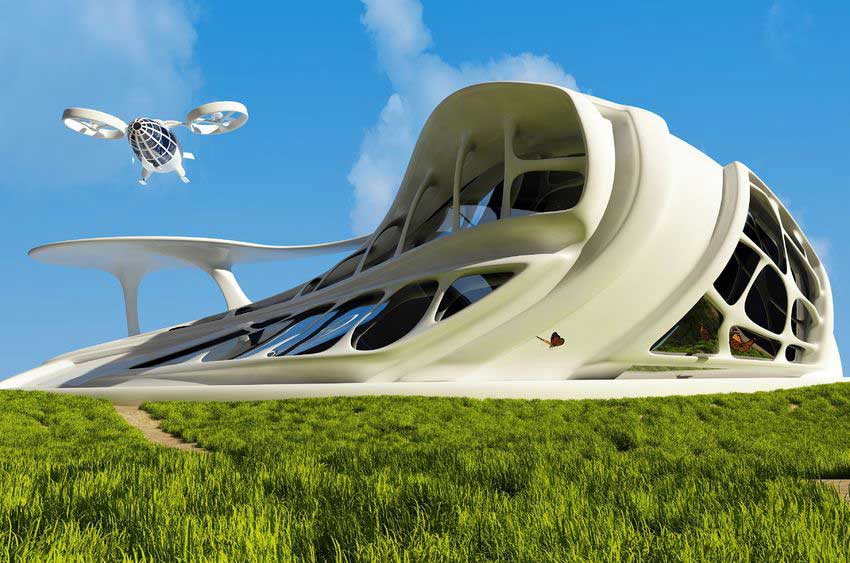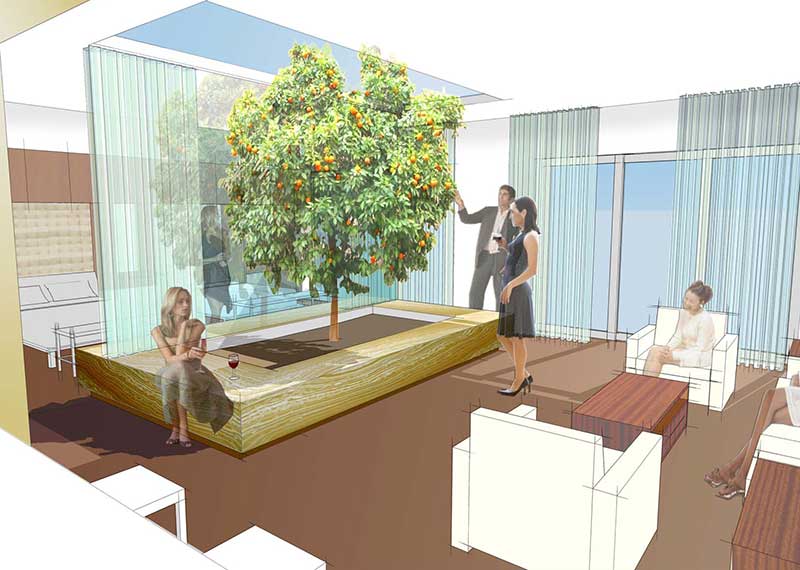
Technology is changing the way we do everything at breathtaking speed, and the spa experience is no exception. But tech is not the only thing effecting change in the industry. Shifts towards mindfulness and a focus on personal “wellness” outside of the medical sector are also drivers of change.
Spa Executive delved into some of the research and technological developments, and spoke to some of the people who are both driving and predicting these shifts about what spas of the future will look (and smell and sound) like a few years from now.
These people are:
Dr. James Canton, CEO, Global Futurist
Aaron Nicholson, Co-Founder and CEO of Studio Transcendent
Robert Henry, Owner, Robert D. Henry Architects
Here’s what you need to know about spas of the future: Spas are literally going to change how we live and how long we live our lives
Consumer genomics are going to change everything

Futurist James Canton says, “One thing we all have in common is none of us know when we’re going to be ill, or when we’re going to die. That’s going to go away. People are going to have access to technology through their healthcare system, their doctor, their clinic, or their app that will give them data about their health status, and what they can do to enhance it and prevent certain conditions from emerging.”
Research shows that knowledge is what consumers want. A recent UK survey found that 85% of respondents would be prepared to undergo genetic testing, while 44% indicated that they would be willing to pay for it. Canton also points out that millennials and Gen Xers are more interested in mapping their genome than Baby Boomers. And that as Gen Xers and millennials are getting older and becoming more affluent, they are driving the market for this information.
Consumer genetic testing and other forms of accessible diagnostics are in their infancy now, but the possibilities are immense.
“This is all still the dark ages,” Canton continues, “but over the next five years, we’ll know a lot more.
Spas will become centres of longevity and life extension.
According to Canton, within less than five years we will have access to a whole new field of consumer genomics targeted at prevention and predictive health.
He says, “A fusion of next generation wellness and health informatics is going to create a new era for spas. The information to which we will have access will allow spas to design personalized programs for enhancement and prevention. If I’m going on vacation for a week to a spa, I want to get to the next level of my health and wellbeing. I don’t want to just lose a few pounds, or just relax. I’d like to get some insight so I can live an extra, vital 20, 30 or more years.”
Meanwhile, tools like CRISPR CAS9 will allow us to engineer genes, editing out potential threats like Alzheimer’s or certain types of cancers.
“The spa of the future is going to look very different,” says Canton. “People are going to go to a spa and have a completely different kind of experience, one that really rejuvenates their health and wellbeing, and enables them to do more, live longer, and be healthier. I think that spas could lead a revolution.”
Some spas will likely just continue to do what they do today, while others will meld new available technology and data with the traditional experience to varying degrees.
At the ultimate degree of this, spa, longevity, and health enhancement merge into human design clinics.
Canton calls this “Human 2.0” and describes it this way:
“You have a spa treatment, a Botox treatment, you get rid of your wrinkles, a little lipo, a breast augmentation, maybe take care of those cancer cells, you get a great massage, a rigorous workout, a few cybernetic enhancements for that hip that’s not been doing so good. They upload some new stuff for you. The inborn nano-device inside of you identifies certain genes that are going to express certain diseases, and we neutralize them. Early Alzheimer’s might be edited out.”
Canton predicts this scenario emerging within those same five years, and points out that clinics already offer some of these things, such as stem cells and other “life extension” treatments, to a small market of cutting-edge elite.
Spas will offer a whole mind-body VR experience

Virtual Reality will play a key role, of course, and is already being used for wellness, relaxation, and stress reduction. Studio Transcendent partnered with AppliedVR to create a guided relaxation experience that has proven to reduce perceived anxiety by 60% in a medical setting. And VR is already being used as an alternative to drugs and medication for pain and stress relief.
Studio Transcendent’s Aaron Nicholson says, “VR will allow spas to extend the soothing world that they embody by giving customers experiences of being in other places such as a vast jungle, the foot of a temple, or a remote mountain hot spring while experiencing local spa services. Used in waiting rooms, VR can prepare guests with guided relaxation or meditation before a treatment. It can also be used to educate guests about the service that they are about to enjoy and highlight other services available.”
But that’s just the beginning. In the future, says Nicholson “VR will be combined with direct brain interfaces to send soothing neural impulses along with photoreal imagery and audio from an almost imperceptible device that is communicating directly into a person’s nervous system.”
Spas will be living, responsive environments

“Wellness Architecture” was identified as on of the 8 Wellness Trends for 2017 – and Beyond at the 2017 Global Wellness Summit. What does this mean? It means sustainable, “living,” and responsive buildings with pristine air quality. It means focus on acoustics, light, temperature, scent, and biophilic design.
The spa environment will move in this direction as people develop more of an understanding of the impact of environment on health and wellbeing. This includes both measurable pollutants and more esoteric factors like the psychological and physiological response to stimuli like sound and scent.
Architect Robert Henry says, “Imagine integrating all the senses into an experiential journey for guests. The more senses you can engage to create the surrounding experience, the more committed it is to your memory. Ideally, you want it to be all favorable. We delve into the psychology of space.”
Spas will become places to seek out human connection

People already go to spas for the physical touch and to be the focus of someone’s attention. In the future, spas will also have to create environments to nurture human connection and community as people start to take other elements of the spa home with them.
Robert Henry says, “People who would visit spas or hotels are asking us to do their homes. We’re bringing all this technology and these experiences right to people’s living rooms, and I think the question becomes how one differentiates these experiences. When we design these really nurturing worlds right within our homes, one wonders if we’ll all even leave the convenience of our own personal cocoons.”
That’s where community comes in.
“You can get a massage or a workout in your home, but you won’t get that shared experience unless you’re sweating alongside someone, or relaxing and sharing stories in the waters,” says Henry. “I think spas are going to create new kinds of social experiences to compete with the home environment. We’re seeing a lot of spas that are fashion-forward regarding this, and that address those socialization needs with communal pools, saunas, and hammams that take a larger audience into account — and that create something memorable, as well as Instagrammable. It’s visual and experiential.”
Henry also believes that our reliance on technology and automation has the risk of “dehumanizing” us.
And so, he says, “The high touch in spa and having people touch us on a human level — whether it be physically, emotionally, or psychologically — is going to become even more important.”
Your manicurist might be a robot – but people will still want people

Guests will seek out humans to provide specific services, while others will be automated. In the somewhat distant future, as booking becomes increasingly automated and software takes over much of the minutiae of CRM management, spas may find themselves without a need for front desk staff. A 2013 report from Carl Benedikt Frey and Michael A. Osborne at Oxford University stated that receptionist is among the job most likely to be automated in or around the next decade or two, with a 96% likelihood of automation. Perhaps surprisingly, manicurists and pedicurists were also at a high likelihood — 95% — for automation in the same time frame. Massage therapists fared better with a 55% likelihood of automation, despite the recent development of massage robots. People will still want to be touched by people – but we won’t need them to do our nails.
The revolution will come quickly
Allowing James Canton to have the last word, the futurist warns that spa leaders should start prepping for his Human 2.0 scenario now.
“I think spa leaders should get out in front of this, and understand that the consumer marketplace is going to be shifting and changing. Millennials will be living perhaps a decade longer than the boomers and at least five-seven years longer than Gen Xers. So, you could end up with middle age being in the 70s. And I don’t think any spa leader is ready for that today.”
(Images in order: Copyright: 1971yes / 123RF Stock Photo, Copyright: luchschen / 123RF Stock Photo, Copyright: ealisa / 123RF Stock Photo, Copyright: bernardbodo / 123RF Stock Photo, Copyright: sarah5 / 123RF Stock Photo)
Spa Executive magazine is published by Book4Time, the world’s most innovative spa, salon, wellness, and activity management software. Learn more at Book4Time.com




I think this is just an apt article. Lovely. And I think spot on for future of spas. I agree with this.
Thanks so much
Great arricle and I believe will be happening over the coming years. The spa industry/directors need to take note and start thinking about this, even education as it will all lead to change.
Such an interesting and exciting read! Thank you.
My company is poised to succeed in product and experience development and already ahead of the learning curve. Great article! Wellness tourism is a huge segment – time away from work to get better and or maintain wellness is more important to consumers. Products and therapies learned on these trips continue at home. Our Online Spa division is coming soon.
This is what I envisioned years ago, it’s so surreal to see this article. Always forward thinking✨